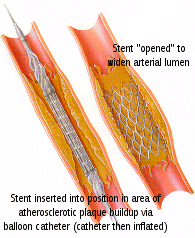Big C Discount Drugs Health Information
Arterial Stents in Coronary Disease
Stents Hold the Arterial Wall Open
 Coronary artery disease is caused by a buildup of plaque on the walls of the coronary arteries. Plaque narrows the vessels and blocks blood flow to the heart. Eventually, it can trigger a heart attack. One of the symptoms of coronary artery disease is chest pain (angina). If changes in lifestyle such as diet, exercise, and smoking cessation, along with medications, do not improve symptoms, angioplasty or cardiac bypass surgery may be needed. Angioplasty is a procedure in which a tiny balloon is inserted into a blocked coronary artery through a small catheter until it reaches the blocked area. Then the balloon is inflated, enlarging the narrowed artery and allowing blood to flow through the artery again. To prevent the artery from collapsing later, a stent may be used to keep the artery open. A stent is a support that permanently holds open the walls of a blocked artery so that blood can flow through. Stents are now used in up to 75% of all angioplasty procedures, with good success and few complications.
Coronary artery disease is caused by a buildup of plaque on the walls of the coronary arteries. Plaque narrows the vessels and blocks blood flow to the heart. Eventually, it can trigger a heart attack. One of the symptoms of coronary artery disease is chest pain (angina). If changes in lifestyle such as diet, exercise, and smoking cessation, along with medications, do not improve symptoms, angioplasty or cardiac bypass surgery may be needed. Angioplasty is a procedure in which a tiny balloon is inserted into a blocked coronary artery through a small catheter until it reaches the blocked area. Then the balloon is inflated, enlarging the narrowed artery and allowing blood to flow through the artery again. To prevent the artery from collapsing later, a stent may be used to keep the artery open. A stent is a support that permanently holds open the walls of a blocked artery so that blood can flow through. Stents are now used in up to 75% of all angioplasty procedures, with good success and few complications.Stents are used in a procedure known as angioplasty to keep open arteries blocked by buildup of plaque. A balloon and the accompanying stent are threaded into the blocked artery, first to open it and then to prevent it from collapsing.
Stents Maintain Blood Flow
Coronary artery disease is caused by a buildup of plaque (hardened fat deposits) on the walls of the coronary arteries, leading to a narrowing of the vessels and poor blood flow to the heart. The primary symptom of coronary artery disease is chest pain (angina). A blocked coronary artery can trigger a heart attack. Coronary artery disease is treated first with diet, exercise, and smoking cessation (if applicable). If these do not improve blood flow, medications can be used. In some patients, however, cardiac bypass surgery or angioplasty may be needed.Cardiac Bypass Surgery vs. Angioplasty: Cardiac bypass surgery reroutes the blood around the blocked artery. It is effective, but it is major surgery, requires extensive recovery, and is expensive. Angioplasty is a procedure that avoids surgery, requires a brief hospital stay, and is much less costly than bypass surgery. Angioplasty was first developed over 20 years ago. It is very common today, and can now be performed in patients who have a blockage covering large areas, severe blockage, blockage of more than one artery, or who have an artery blocked in more than one place. Even patients whose chest pain is controlled by medication may have better results with angioplasty.
What Are Coronary Stents? Coronary artery stents were first used in 1986, and are now used in almost 75% of all angioplasty procedures. Before undergoing angioplasty, a patient will have a coronary arteriogram, a procedure in which a physician inserts a large needle into an artery in the leg or arm. A guide wire is threaded through the needle and follows the arterial system through the aorta into the blocked coronary artery. Then a catheter, or narrow tube, is inserted over the guide wire. A dye is injected into the catheter and a moving x-ray shows exactly where a blockage or plaque is located. In performing angioplasty to open up the blocked artery, the physician uses a special catheter with a tiny balloon at its tip. The balloon is placed exactly where the plaque is located, and is inflated several times, each time further widening the narrowed artery. The balloon actually compresses or crushes the hardened plaque, but it may weaken the artery wall. In about three-quarters of the patients, a stent is used with the balloon. The stent is opened as the balloon is inflated; then the balloon is deflated and removed. The stent remains as a permanent support to keep the artery from collapsing. After a few weeks, the artery lining grows over the surface of the stent. Arterial stents are usually made of metal and come in a variety of styles, including a coiled spring and an expanding mesh. Newer polymer stents are being introduced, and some are even made with drugs or chemicals embedded in them that help prevent the artery from becoming blocked again. Stents that expand slowly by themselves after they are placed in the blocked artery have also been developed. After a stent has been implanted, a patient is placed on one or more drugs (for example, aspirin, Coumadin, or ticlopidine) for the first 4 to 6 weeks to help prevent blood clots from forming. Typically, a patient will be instructed to take aspirin for an indefinite period of time. Angioplasty and stent implantation only correct the existing blockage of blood flow through narrowed coronary arteries. To slow the further buildup of plaque, follow your doctor's advice about diet, exercise and medications. Your pharmacist can answer questions you may have about medications.
